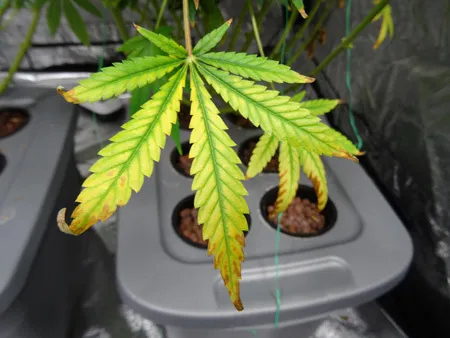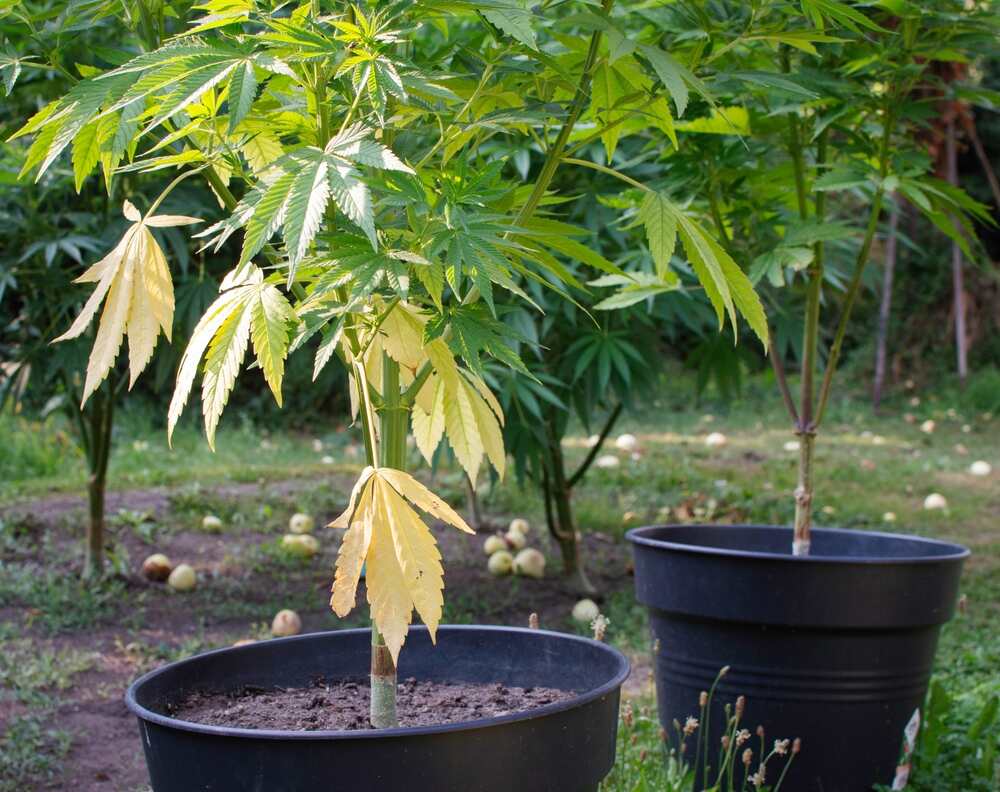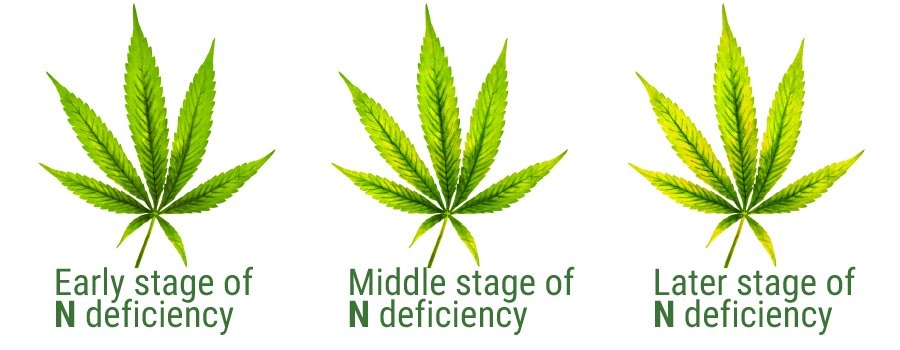The Best Fluffy Pancakes recipe you will fall in love with. Full of tips and tricks to help you make the best pancakes.

Identify and Fix Nitrogen Deficiency in Cannabis
When you’re growing weed, one of the key things to keep an eye on is your plant’s nutrient intake, especially nitrogen. Nitrogen plays a major role in plant growth, and if your marijuana isn’t getting enough of it, you’ll start to see some clear signs. Don’t worry, though—if you’re noticing your plants are struggling, this guide will help you identify and fix nitrogen deficiency quickly. Whether you’re growing in soil or hydroponically, I’ve got your back.
What is Nitrogen Deficiency in Cannabis?

Nitrogen deficiency is when your weed plants aren’t getting enough nitrogen, which can slow their growth and lead to some pretty gnarly-looking leaves. The good news is that it’s usually easy to spot and treat if you know what to look for.
Overview of nitrogen’s role in cannabis growth
Nitrogen is a big deal for marijuana. It helps the plant produce chlorophyll, which allows it to use sunlight for food—basically, photosynthesis. It also plays a role in making amino acids, proteins, and enzymes that fuel your plant’s growth. Without enough nitrogen, your plants can’t grow as fast or as strong, and they’ll lose that vibrant green color.
Symptoms of nitrogen deficiency in cannabis plants
The biggest sign of nitrogen deficiency is yellowing leaves, particularly the older ones at the bottom of the plant. Your marijuana will start to look sickly, with slow growth, weak stems, and leaves turning yellow and eventually brown. Sometimes, the leaves curl up or get crispy around the edges.
Difference between nitrogen deficiency and other nutrient issues
A lot of nutrient deficiencies can cause yellowing leaves, so how do you know it’s nitrogen and not something else? Well, nitrogen deficiency tends to affect the lower leaves first, whereas other nutrient problems (like magnesium or calcium deficiency) might start higher up. Also, nitrogen-deficient plants will often grow slower and look a bit “leggy.”
Causes of Nitrogen Deficiency in Cannabis Plants
Nitrogen deficiency can sneak up on you for a few reasons. Luckily, once you know the causes, it’s easier to fix and prevent.
Poor soil quality and lack of nutrients
One of the most common causes of nitrogen deficiency is simply poor soil. If your soil doesn’t have enough nutrients, or if it’s old and depleted, your plants aren’t going to get the nitrogen they need. Sometimes you just need to give your soil a little boost with the right nutrients.
pH imbalances affecting nitrogen absorption
Even if you’re feeding your plants plenty of nitrogen, if the pH of your soil or water is off, your cannabis can’t absorb it properly. Cannabis likes a pH range of 6.0 to 7.0 in soil and 5.5 to 6.5 in hydroponics. If your pH is outside this range, the roots won’t take up nitrogen, even if it’s available.
Overwatering or underwatering issues
Watering problems can mess with nitrogen absorption too. If you overwater, the roots can get waterlogged and have trouble taking up nutrients. Underwatering, on the other hand, can lead to nutrient lockout because the soil gets too dry and compacted.
Ineffective or outdated fertilizer use
Using the wrong type of fertilizer or sticking with an old one for too long can cause nitrogen deficiency. If you’re using a fertilizer that’s low in nitrogen or one that’s been sitting around for a while, your plants might not be getting the nutrients they need.
How to Identify Nitrogen Deficiency in Cannabis

Identifying nitrogen deficiency early is key to keeping your plants happy and healthy.
Visual signs in leaves (yellowing and browning)
The most obvious sign is yellowing leaves at the base of the plant. As the deficiency worsens, the leaves might turn brown and crispy around the edges. Eventually, they’ll fall off. If you spot this early on, you can take steps to fix it before too many leaves are lost.
Slowed growth patterns and stunted development
If your plants are growing slower than usual, or they look thin and stretched out, nitrogen deficiency could be the culprit. Nitrogen is critical for growth, so a lack of it can stunt your plant’s development.
Using soil tests and other diagnostic tools
A soil test kit can help you confirm whether your soil is low in nitrogen. You can grab one online or from a local garden center. Alternatively, you can use a pH meter to check the pH levels, which will help you figure out if the issue is nitrogen lockout due to pH imbalances.
Common stages of growth when nitrogen deficiency appears
Nitrogen deficiency usually shows up during the vegetative stage, as this is when your plant needs nitrogen the most. However, it’s still possible for deficiency to occur later on, especially if your plant is a heavy feeder or if your soil is depleted.
How to Fix Nitrogen Deficiency in Cannabis
Fixing nitrogen deficiency is all about getting more nitrogen to your plants ASAP. Here’s how I usually handle it.
Adjusting nutrient levels in soil or hydroponic systems
The first thing you’ll want to do is boost the nitrogen levels. You can add a nitrogen-rich fertilizer or nutrient mix specifically designed for cannabis. Look for something with a higher N-P-K ratio (the “N” stands for nitrogen).
Using organic vs synthetic nitrogen supplements
Both organic and synthetic nitrogen sources can work, but they have their pros and cons. Organic options, like compost or blood meal, are great for long-term soil health, while synthetic fertilizers deliver fast results. I usually prefer organic, but if you’re in a pinch, synthetic can get the job done quickly.
Importance of nitrogen-fixing plants and compost
If you’re growing outdoors, you can use nitrogen-fixing plants like clover or alfalfa to naturally boost nitrogen levels. Compost is also a great way to add organic matter that’s rich in nitrogen and other nutrients. I’ve had success using compost teas as well.
Best practices for monitoring plant recovery
After you’ve adjusted the nitrogen levels, keep an eye on your plants for signs of improvement. New growth should be green and healthy, and the yellowing should stop spreading. Give it about a week, and if things don’t improve, you might need to tweak your approach.
Preventing Nitrogen Deficiency in Future Cannabis Grows
Prevention is way better than cure. Here’s how to keep nitrogen deficiency from creeping up on you in future grows.
Best fertilizers and nutrient products for cannabis
I always recommend using a balanced nutrient mix, especially one formulated for marijuana. During the vegetative stage, you want something higher in nitrogen, like a 3-1-2 N-P-K ratio.
Importance of regular soil testing
Testing your soil regularly is an easy way to keep track of nutrient levels and prevent deficiencies before they start. You can test your pH and nutrient content at least once per grow cycle, or more often if you’re having issues.
Creating a feeding schedule to balance nutrients
A good feeding schedule is key. Make sure you’re giving your plants the right amount of nitrogen at each stage of growth. During the vegetative stage, they’ll need more, while in flowering, you can back off a bit.
Tips for long-term soil and plant health
For long-term success, focus on keeping your soil healthy. This means rotating crops, adding organic matter like compost, and avoiding chemical fertilizers that can deplete the soil over time.
Nitrogen Toxicity vs. Nitrogen Deficiency: Key Differences
Sometimes, people mistake nitrogen toxicity for nitrogen deficiency, but they’re very different problems.
Symptoms of nitrogen toxicity
With nitrogen toxicity, your weed plant will have dark, shiny leaves and may experience leaf clawing (when the tips of the leaves curl downward). Plants may also grow too fast and become weak or brittle.
How to remedy nitrogen toxicity
To fix nitrogen toxicity, flush the soil with water to wash out the excess nutrients. If you’re growing hydroponically, you can reduce the nutrient solution’s nitrogen levels and give your plants a little break from feeding.
Balancing nutrient intake to avoid toxicity and deficiency
The key to avoiding both nitrogen toxicity and deficiency is balance. Stick to a good nutrient schedule and make sure you’re not overfeeding or underfeeding your plants.
FAQ
What does nitrogen deficiency look like in cannabis?
Yellowing lower leaves, slow growth, and weak stems are common signs of nitrogen deficiency in cannabis. The leaves may turn brown and crispy before falling off if the issue is not addressed.
How long does it take to fix nitrogen deficiency in cannabis plants?
Most plants will show signs of recovery within a week of correcting the deficiency, though it may take a bit longer for severely affected plants.
Can nitrogen deficiency kill cannabis plants?
If left untreated, nitrogen deficiency can severely stunt plant growth and reduce yields, but it’s rare for it to outright kill a cannabis plant.
Is nitrogen deficiency more common in soil or hydroponic systems?
It can happen in both, but it’s more common in soil, especially if the soil isn’t well-maintained or if the pH is off.
Can nitrogen deficiency affect cannabis yields?
Yes, if nitrogen deficiency isn’t corrected, it can lead to reduced growth and smaller yields, as your plant won’t have the nutrients it needs to thrive.
Nitrogen deficiency in cannabis is definitely one of the more common issues growers face, but with the right know-how, you can fix it quickly and prevent it from happening again. Just keep an eye on your plants, adjust your feeding, and remember to test your soil regularly. Learn as you grow, and your marijuana plants will reward you!




